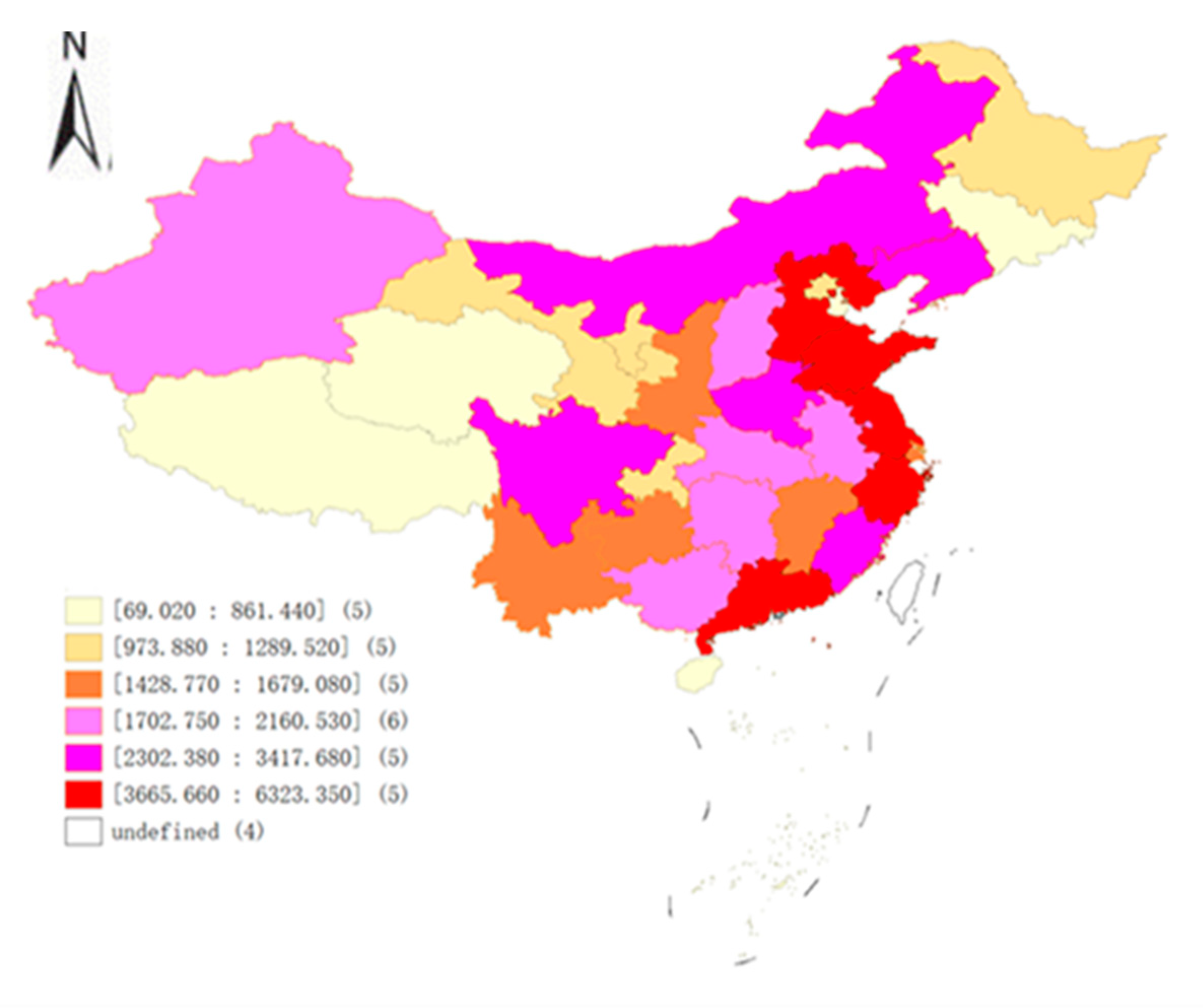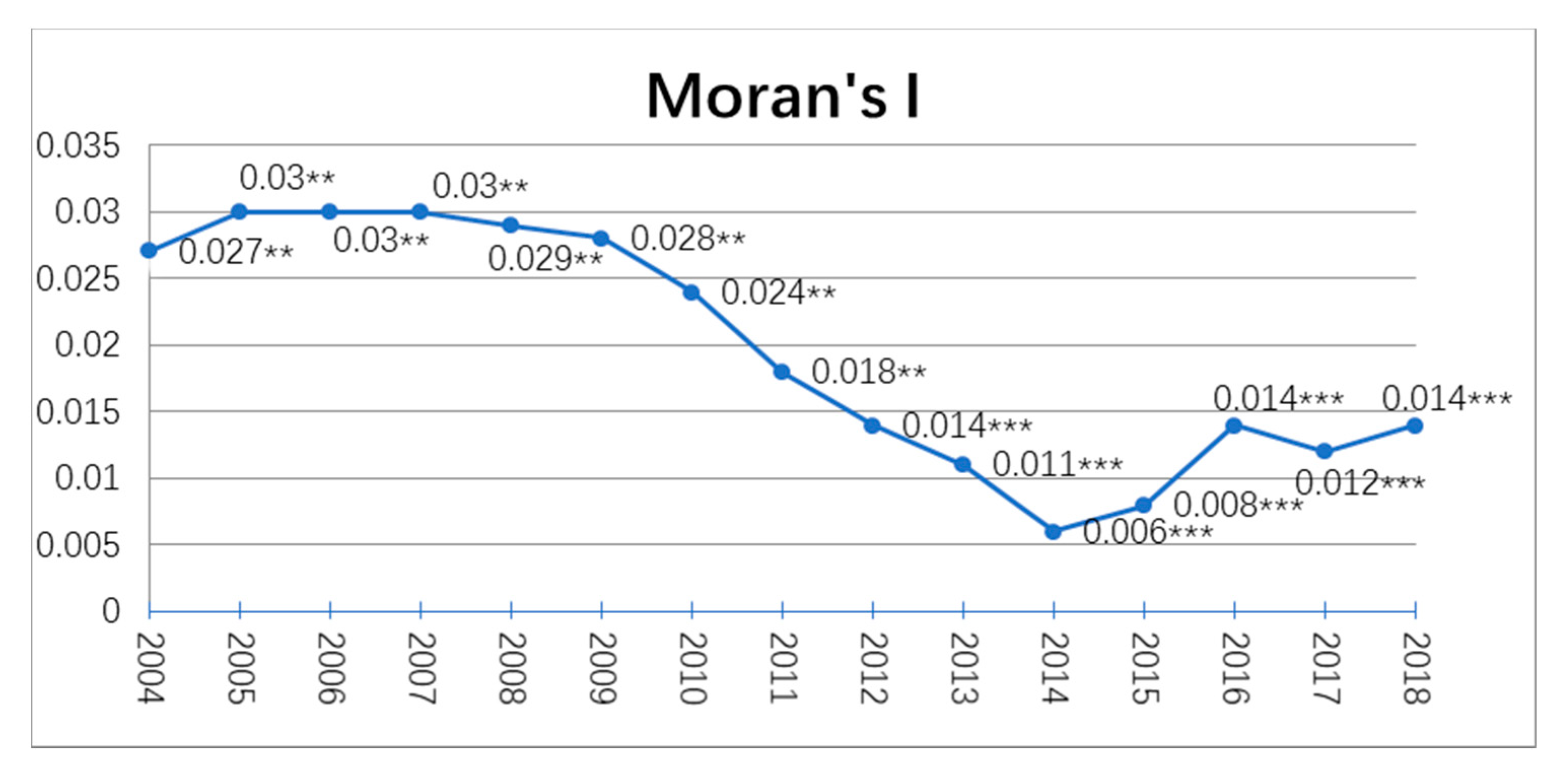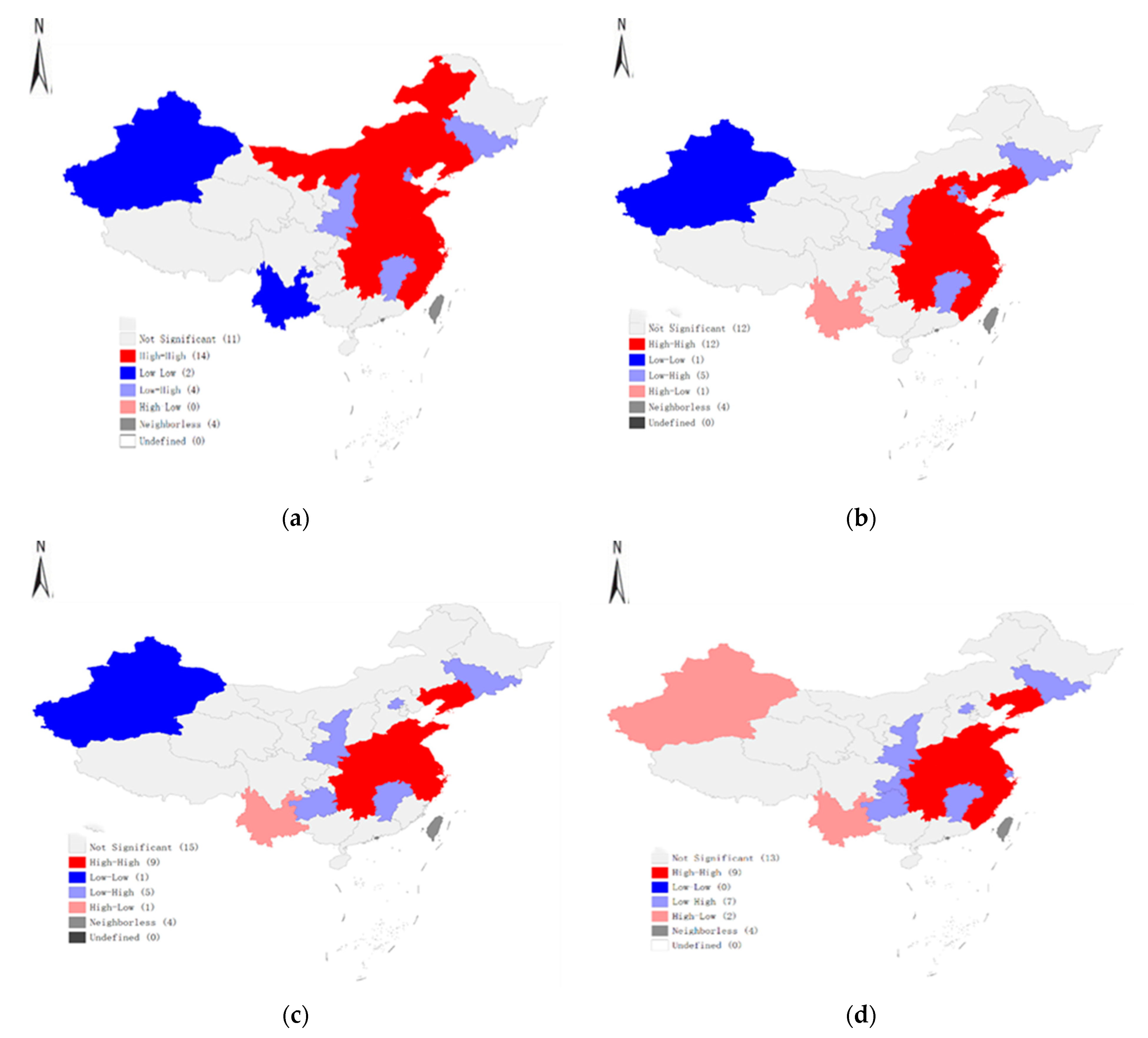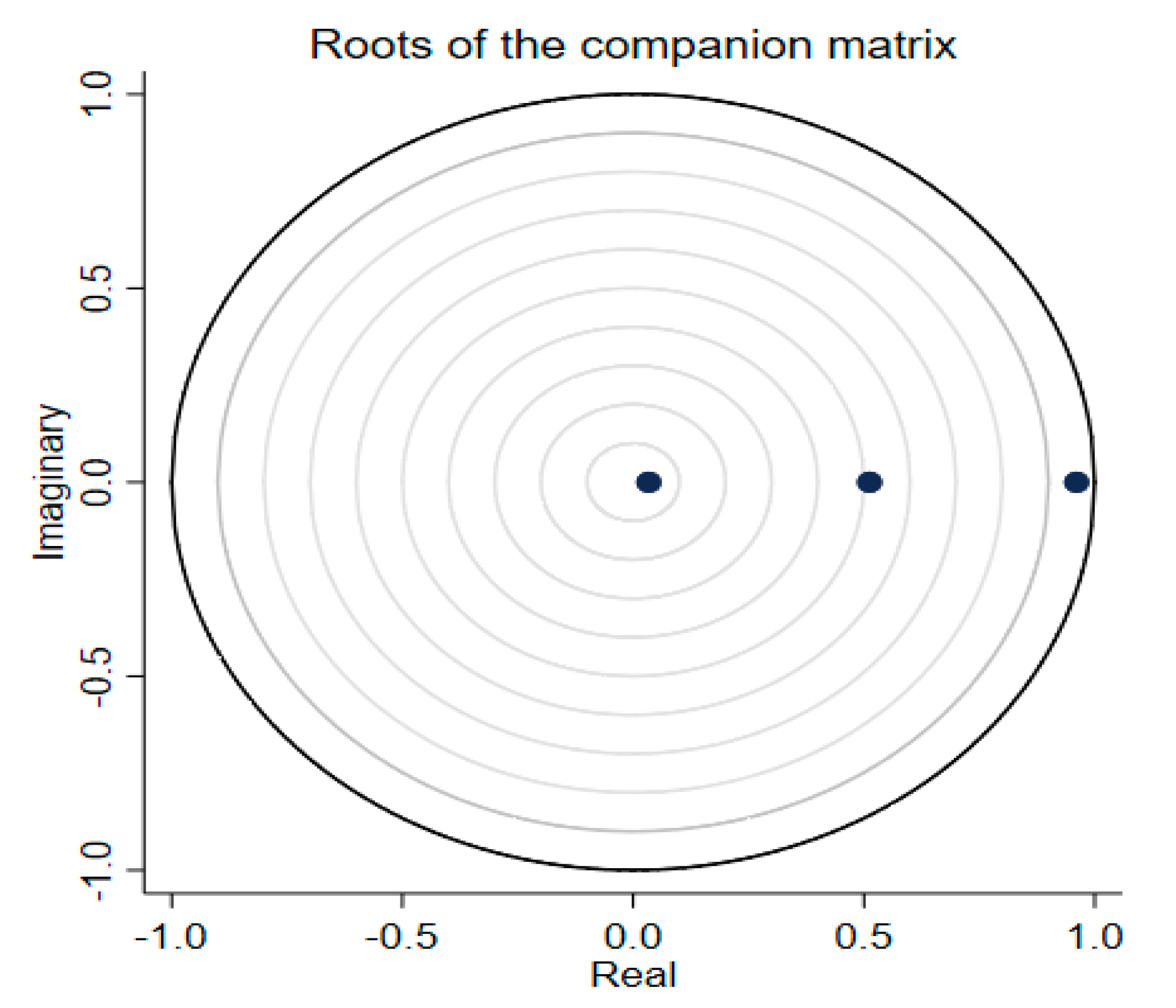Electricity Consumption in China: The Effects of Financial Development and Trade Openness
Abstract
:1. Introduction
2. Literature Review
3. Methodology
3.1. Variables and Data
| Variable Name | Symbol | Definition |
|---|---|---|
| Electricity consumption | ec | The amount of electricity consumption in different provinces in units of 108 kWh |
| Financial development | fde | The ratio of total credit to the region’s nominal GDP |
| Trade openness | tro | The proportion of total import and export trade with the use of official exchange rates to the region’s nominal GDP |
| Economic growth | pgdp | Per capita GDP in different provinces [29,36] |
| Foreign direct investment | fdi | Foreign direct investment according to the exchange rate of USD in each year [37,38,39] |
| Fixed asset investment | fai | The ratio of fixed asset investment to the region’s nominal GDP [40] |
| Industrialization | ind | The ratio of industrial value added to the region’s nominal GDP [34,41] |
| Urbanization | urb | The ratio of urban population to the total population [42,43] |
3.2. Panel Unit Root Test
3.3. Pedroni Cointegration Test
3.4. Spatial Correlation Test
3.5. Spatial Econometric Model
3.6. The PVAR Approach
4. Results and Discussion
4.1. Panel Unit Root and Panel Cointegration Tests
4.2. Results of Spatial Autocorrelation
4.3. Results of Spatial Model
4.4. PVAR Estimation Results
4.4.1. PVAR Lag Selection
4.4.2. Stability of the PVAR Model
4.4.3. Granger Causality Test
4.4.4. Impulse Response Function (IRF)
5. Conclusions and Policy Implications
Author Contributions
Funding
Institutional Review Board Statement
Informed Consent Statement
Data Availability Statement
Conflicts of Interest
Abbreviations
| PVAR | Panel vector autoregression |
| WTO | World Trade Organization |
| ARDL | Autoregressive distributed lag |
| VECM | Vector error correction method |
| GMM | Generalized method of moments |
| AIC | Akaike information criterion |
| HQIC | Hannan Quine information criterion |
| LLC | Levin-Lin-Chu |
| IPS | Im-Pesaran-Shin |
| REC | Residential electricity consumption |
| IEC | Industrial electricity consumption |
| SAR | Spatial autoregressive model |
| SEM | Spatial error model |
| SDM | Spatial Durbin model |
| BIC | Bayesian information criterion |
| IRF | Impulse response function |
| HT | Harris-Tzavalis |
References
- IEA. World Energy Outlook 2019; International Energy Agency: Paris, France, 2019; Available online: https://www.iea.org/reports/world-energy-outlook-2019 (accessed on 14 August 2021).
- Lin, B.; Li, Z. Is more use of electricity leading to less carbon emission growth? An analysis with a panel threshold model. Energy Policy 2020, 137, 111121. [Google Scholar] [CrossRef]
- IEA. Data-CO2 Emissions; International Energy Agency: Paris, France, 2021; Available online: https://www.iea.org/data-and-statistics (accessed on 7 August 2021).
- Zhou, G.; Chung, W.; Zhang, Y. Measuring energy efficiency performance of China’s transport sector: A data envelopment analysis approach. Expert Syst. Appl. 2014, 41, 709–722. [Google Scholar] [CrossRef]
- Sadorsky, P. The impact of financial development on energy consumption in emerging economies. Energy Policy 2010, 38, 2528–2535. [Google Scholar] [CrossRef]
- Liu, S.; Li, H. Does Financial Development Increase Urban Electricity Consumption? Evidence from Spatial and Heterogeneity Analysis. Sustainability 2020, 12, 7011. [Google Scholar] [CrossRef]
- Gregori, T.; Tiwari, A.K. Do urbanization, income, and trade affect electricity consumption across Chinese provinces? Energy Economics 2020, 89, 104800. [Google Scholar] [CrossRef]
- Sbia, R.; Shahbaz, M.; Hamdi, H. A contribution of foreign direct investment, clean energy, trade openness, carbon emissions and economic growth to energy demand in UAE. Econ. Model. 2014, 36, 191–197. [Google Scholar] [CrossRef] [Green Version]
- An, H.; Xu, J.; Ma, X. Does technological progress and industrial structure reduce electricity consumption? Evidence from spatial and heterogeneity analysis. Struct. Chang. Econ. Dyn. 2020, 52, 206–220. [Google Scholar] [CrossRef]
- Sadorsky, P. Information communication technology and electricity consumption in emerging economies. Energy Policy 2012, 48, 130–136. [Google Scholar] [CrossRef]
- Shahbaz, M.; Feridun, M. Electricity consumption and economic growth empirical evidence from Pakistan. Qual. Quant. 2012, 46, 1583–1599. [Google Scholar] [CrossRef]
- Salahuddin, M.; Alam, K. Internet usage, electricity consumption and economic growth in Australia: Time series evidence. Telemat. Inform. 2015, 32, 862–878. [Google Scholar]
- Al-Bajjali, S.K.; Shamayleh, A.Y. Estimating the determinants of electricity consumption in Jordan. Energy 2018, 147, 1311–1320. [Google Scholar] [CrossRef]
- Kumari, A.; Sharma, A.K. Causal relationships among electricity consumption, foreign direct investment and economic growth in India. Electr. J. 2018, 31, 33–38. [Google Scholar] [CrossRef]
- Lin, B.; Wang, Y. Inconsistency of economic growth and electricity consumption in China: A panel VAR approach. J. Clean. Prod. 2019, 229, 144–156. [Google Scholar] [CrossRef]
- Taale, F.; Kyeremeh, C. Drivers of households’ electricity expenditure in Ghana. Energy Build. 2019, 205, 109546. [Google Scholar] [CrossRef]
- Benjamin, N.I.; Lin, B. Influencing factors on electricity demand in Chinese nonmetallic mineral products industry: A quantile perspective. J. Clean. Prod. 2019, 243, 118584. [Google Scholar] [CrossRef]
- Zhang, M.; Chen, Y.; Hu, W.; Deng, N.; He, W. Exploring the impact of temperature change on residential electricity consumption in China: The ‘crowding-out’ effect of income growth. Energy Build. 2021, 245, 111040. [Google Scholar] [CrossRef]
- Rafindadi, A.A.; Ozturk, I. Effects of financial development, economic growth and trade on electricity consumption: Evidence from post-Fukushima Japan. Renew. Sustain. Energy Rev. 2016, 54, 1073–1084. [Google Scholar] [CrossRef]
- Sbia, R.; Shahbaz, M.; Ozturk, I. Economic growth, financial development, urbanisation and electricity consumption nexus in UAE. Econ. Res.-Ekon. Istraživanja 2017, 30, 527–549. [Google Scholar] [CrossRef] [Green Version]
- Faisal, F.; Tursoy, T.; Berk, N. Linear and non-linear impact of Internet usage and financial deepening on electricity consumption for Turkey: Empirical evidence from asymmetric causality. Environ. Sci. Pollut. Res. Int. 2018, 25, 11536–11555. [Google Scholar] [CrossRef] [PubMed]
- Solarin, S.A.; Shahbaz, M.; Khan, H.N.; Razali, R.B. ICT, Financial Development, Economic Growth and Electricity Consumption: New Evidence from Malaysia. Glob. Bus. Rev. 2019, 22, 941–962. [Google Scholar] [CrossRef]
- Adom, P.K. Financial depth and electricity consumption in Africa: Does education matter? Empir. Econ. 2020, 1–55. [Google Scholar] [CrossRef]
- Lin, B.; Omoju, O.E.; Okonkwo, J.U. Factors influencing renewable electricity consumption in China. Renew. Sustain. Energy Rev. 2016, 55, 687–696. [Google Scholar] [CrossRef]
- Ohlan, R. The relationship between electricity consumption, trade openness and economic growth in India. OPEC Energy Rev. 2018, 42, 331–354. [Google Scholar] [CrossRef]
- Ghazouani, T.; Boukhatem, J.; Yan Sam, C. Causal interactions between trade openness, renewable electricity consumption, and economic growth in Asia-Pacific countries: Fresh evidence from a bootstrap ARDL approach. Renew. Sustain. Energy Rev. 2020, 133, 110094. [Google Scholar] [CrossRef]
- Sahoo, M.; Sethi, N. Does remittance inflow stimulate electricity consumption in India? An empirical insight. South Asian J. Bus. Stud. 2020. ahead-of-print. [Google Scholar] [CrossRef]
- Anselin, L.; Rey, S.J. Introduction to the Special Issue on Spatial Econometrics. Int. Reg. Sci. Rev. 1997, 20, 1–7. [Google Scholar] [CrossRef]
- Jiang, L.; Ji, M. China’s Energy Intensity, Determinants and Spatial Effects. Sustainability 2016, 8, 544. [Google Scholar] [CrossRef] [Green Version]
- Wu, H.; Xia, Y.; Yang, X.; Hao, Y.; Ren, S. Does environmental pollution promote China’s crime rate? A new perspective through government official corruption. Struct. Chang. Econ. Dyn. 2021, 57, 292–307. [Google Scholar] [CrossRef]
- Zhang, J.; Wang, L.; Wang, S. Financial development and economic growth: Recent evidence from China. J. Comp. Econ. 2012, 40, 393–412. [Google Scholar] [CrossRef]
- Hao, Y.; Wang, L.-O.; Lee, C.-C. Financial development, energy consumption and China’s economic growth: New evidence from provincial panel data. Int. Rev. Econ. Financ. 2020, 69, 1132–1151. [Google Scholar] [CrossRef]
- Yuxiang, K.; Chen, Z. Financial development and environmental performance: Evidence from China. Environ. Dev. Econ. 2010, 16, 93–111. [Google Scholar] [CrossRef]
- Pan, X.; Uddin, M.K.; Saima, U.; Jiao, Z.; Han, C. How do industrialization and trade openness influence energy intensity? Evidence from a path model in case of Bangladesh. Energy Policy 2019, 133, 110916. [Google Scholar] [CrossRef]
- Pan, X.; Uddin, M.K.; Han, C.; Pan, X. Dynamics of financial development, trade openness, technological innovation and energy intensity: Evidence from Bangladesh. Energy 2019, 171, 456–464. [Google Scholar] [CrossRef]
- Zhou, D.; Chen, B.; Li, J.; Jiang, Y.; Ding, X. China’s Economic Growth, Energy Efficiency, and Industrial Development: Nonlinear Effects on Carbon Dioxide Emissions. Discret. Dyn. Nat. Soc. 2021, 2021, 5547092. [Google Scholar] [CrossRef]
- Sarkodie, S.A.; Strezov, V. Effect of foreign direct investments, economic development and energy consumption on greenhouse gas emissions in developing countries. Sci. Total Environ. 2019, 646, 862–871. [Google Scholar] [CrossRef] [PubMed]
- Zhao, X.; Zhang, Y.; Li, Y. The spillovers of foreign direct investment and the convergence of energy intensity. J. Clean. Prod. 2019, 206, 611–621. [Google Scholar] [CrossRef]
- Guo, Z.; Chen, S.S.; Yao, S.; Mkumbo, A.C. Does Foreign Direct Investment Affect SO2 Emissions in the Yangtze River Delta? A Spatial Econometric Analysis. Chin. Geogr. Sci. 2021, 31, 400–412. [Google Scholar] [CrossRef]
- Yan, L.; Guan, Z.; Yang, X. Relationship between Fixed-Asset Investment and Environmental Quality Based on EKC. In LISS 2013; Springer: Berlin/Heidelberg, Germany, 2015. [Google Scholar] [CrossRef]
- Mamipour, S.; Beheshtipour, H.; Feshari, M.; Amiri, H. Factors influencing carbon dioxide emissions in Iran’s provinces with emphasis on spatial linkages. Environ. Sci. Pollut. Res. Int. 2019, 26, 18365–18378. [Google Scholar] [CrossRef]
- Lin, B.; Zhu, J. Energy and carbon intensity in China during the urbanization and industrialization process: A panel VAR approach. J. Clean. Prod. 2017, 168, 780–790. [Google Scholar] [CrossRef]
- Yang, Y.; Liu, J.; Lin, Y.; Li, Q. The impact of urbanization on China’s residential energy consumption. Struct. Chang. Econ. Dyn. 2019, 49, 170–182. [Google Scholar] [CrossRef]
- Rathnayaka, R.M.K.T.; Seneviratna, D.M.K.N.; Long, W. The dynamic relationship between energy consumption and economic growth in China. Energy Sources Part B Econ. Plan. Policy 2018, 13, 264–268. [Google Scholar] [CrossRef]
- Levin, A.; Lin, C.-F.; Chu, C.-S.J. Unit root tests in panel data: Asymptotic and finite-sample properties. J. Econom. 2002, 108, 1–24. [Google Scholar] [CrossRef]
- Harris, R.D.F.; Tzavalis, E. Inference for unit roots in dynamic panels where the time dimension is fixed. J. Econom. 1999, 91, 210–226. [Google Scholar] [CrossRef]
- Im, K.S.; Pesaran, M.H.; Shin, Y. Testing for unit roots in heterogeneous panels. Adv. Econom. 2003, 115, 53–75. [Google Scholar] [CrossRef]
- Engle, R.F.; Granger, C.W.J. Co-integration and error correction: Representation, estimation, and testing. Econometrica 1987, 55, 251–276. [Google Scholar] [CrossRef]
- Pedroni, P. Panel Cointegration: Asymptotic and Finite Sample Properties of Pooled Time Series Tests with an Application to the PPP Hypothesis. Econom. Theory 2004, 20, 597–625. [Google Scholar] [CrossRef] [Green Version]
- Anselin, L. Local Indicators of Spatial Association-LISA. Geogr. Anal. 1995, 27, 93–115. [Google Scholar] [CrossRef]
- Elhorst, J.P. Dynamic Spatial Panels: Models, Methods and Inferences. J. Geogr. Syst. 2012, 14, 5–28. [Google Scholar] [CrossRef]
- Holtz-Eakin, D.; Newey, W.; Rosen, H.S. Estimating Vector Autoregressions with Panel Data. Econometrica 1988, 56, 1371–1395. [Google Scholar] [CrossRef]
- Love, I.; Zicchino, L. Financial development and dynamic investment behavior: Evidence from panel VAR. Q. Rev. Econ. Financ. 2006, 46, 190–210. [Google Scholar] [CrossRef]
- Zouaoui, H.; Zoghlami, F. On the income diversification and bank market power nexus in the MENA countries: Evidence from a GMM panel-VAR approach. Res. Int. Bus. Financ. 2020, 52, 101186. [Google Scholar] [CrossRef]
- Antonakakis, N.; Chatziantoniou, I.; Filis, G. Energy consumption, CO 2 emissions, and economic growth: An ethical dilemma. Renew. Sustain. Energy Rev. 2017, 68, 808–824. [Google Scholar] [CrossRef] [Green Version]
- Charfeddine, L.; Kahia, M. Impact of renewable energy consumption and financial development on CO2 emissions and economic growth in the MENA region: A panel vector autoregressive (PVAR) analysis. Renew. Energy 2019, 139, 198–213. [Google Scholar] [CrossRef]
- Belotti, F.; Hughes, G. Spatial panel-data models using Stata. Stata J. 2017, 1, 139–180. [Google Scholar] [CrossRef] [Green Version]
- LeSage, J.; Pace, R.K. Introduction to Spatial Econometrics; CRC Press, Taylor & Francis Group: New York, NY, USA, 2009. [Google Scholar]
- Sadorsky, P. Financial development and energy consumption in Central and Eastern European frontier economies. Energy Policy 2011, 39, 999–1006. [Google Scholar] [CrossRef]
- Andrews, W.K.D.; Lu, B. Consistent model and moment selection procedures for GMM estimation with application to dynamic panel data models. J. Econom. 2001, 101, 123–164. [Google Scholar] [CrossRef]






| Variables | Unit | Mean | Std. Dev | Min | Max |
|---|---|---|---|---|---|
| lnec | 108 kWh | 6.909 | 1.028 | 2.163 | 8.752 |
| lnfde | % | 4.733 | 0.527 | 0.129 | 6.542 |
| lntro | % | 2.882 | 0.982 | 0.523 | 5.148 |
| lnpgdp | Yuan | 10.350 | 0.689 | 8.370 | 11.851 |
| lnfdi | 108 Yuan | 4.993 | 1.807 | −0.059 | 7.722 |
| lnfai | % | 4.174 | 0.581 | −1.020 | 6.370 |
| lnind | % | 3.578 | 0.385 | 1.918 | 3.971 |
| lnurb | % | 3.893 | 0.316 | 2.766 | 4.495 |
| Var. | Level | First Difference | ||||
|---|---|---|---|---|---|---|
| LLC | HT | IPS | LLC | HT | IPS | |
| lnec | −8.543 *** | 0.919 | −5.184 *** | −10.897 *** | 0.290 *** | −4.864 *** |
| lnfde | 1.213 | 0.326 *** | 5.429 | −5.755 *** | −0.568 *** | −8.373 *** |
| lntro | −14.174 *** | 0.253 *** | −5.230 *** | −3.066 *** | −0.501 *** | −12.337 *** |
| lnpgdp | −11.838 *** | 0.923 | −7.596 *** | −3.356 *** | 0.430 *** | −3.071 *** |
| lnfdi | 0.356 | 0.750 | −4.790 *** | −2.935 *** | −0.080 *** | −8.305 *** |
| lnfai | −5.491 *** | 0.425 *** | −0.102 | −3.862 *** | −0.562 *** | −6.873 *** |
| lnind | 3.227 | 0.974 | 7.941 | −6.657 *** | 0.294 *** | −5.641 *** |
| lnurb | −0.177 | 0.585 *** | −10.303 *** | −4.761 *** | 0.003 *** | −15.183 *** |
| Statistic | p-Value | |
|---|---|---|
| Modified Phillips–Perron t | 2.8138 | 0.0024 |
| Phillips–Perron t | 3.1052 | 0.0010 |
| Augmented Dickey–Fuller t | 2.5965 | 0.0047 |
| OLS | SAR | SEM | SDM | |
|---|---|---|---|---|
| lnfde | 0.112 *** (3.93) | 0.066 ** (2.57) | 0.104 *** (3.83) | 0.093 *** (3.29) |
| lntro | −0.047 ** (−2.08) | −0.062 *** (−2.88) | −0.062 *** (−2.76) | −0.053 ** (−2.28) |
| lnpgdp | 0.648 *** (24.22) | 0.389 *** (7.53) | 0.639 *** (21.38) | 0.310 *** (4.44) |
| lnfdi | −0.020 (−1.64) | −0.008 (−0.69) | −0.011 (−0.95) | −0.014 (−1.18) |
| lnfai | −0.078 *** (−2.78) | −0.041 (−1.64) | −0.071 *** (−2.64) | −0.072 *** (−2.60) |
| lnind | 0.011 (0.20) | 0.001 (0.003) | −0.048 (−1.06) | 0.176 *** (2.56) |
| lnurb | 0.230 *** (3.24) | 0.143 ** (2.09) | 0.159 * (1.91) | 0.116 (1.27) |
| W*lnfde | −0.224 ** (−2.00) | |||
| W*lntro | 0.124 * (1.71) | |||
| W*lnpgdp | 0.085 (0.67) | |||
| W*lnfdi | −0.105 (−1.47) | |||
| W*lnfai | 0.304 *** (2.85) | |||
| W*lnind | −0.444 *** (−4.05) | |||
| W*lnurb | 0.251 (1.60) | |||
| or λ | 0.386 *** (5.28) | 0.398 *** (3.10) | 0.352 *** (2.66) | |
| 0.899 | 0.902 | 0.898 | 0.906 | |
| LogL | 207.227 | 199.073 | 218.090 | |
| Wald spatial lag | 21.17 *** | |||
| LR spatial lag | 20.64 *** | |||
| Wald spatial error | 18.93 *** | |||
| LR spatial error | 38.03 *** |
| Independent Var. | Direct Effects | Indirect Effects | Total Effects |
|---|---|---|---|
| lnfde | 0.089 *** (3.10) | −0.301 * (−1.71) | −0.211 (−1.19) |
| lntro | −0.051 ** (−2.31) | 0.171 (1.53) | 0.120 (1.08) |
| lnpgdp | 0.322 *** (4.89) | 0.287 ** (2.28) | 0.609 *** (5.52) |
| lnfdi | −0.016 (−1.43) | −0.171 (−1.38) | −0.187 (−1.48) |
| lnfai | −0.065 ** (−2.39) | 0.432 ** (2.37) | 0.368 ** (2.00) |
| lnind | 0.163 ** (2.57) | −0.594 *** (−3.52) | −0.431 *** (−2.72) |
| lnurb | 0.121 (1.31) | 0.460 ** (1.98) | 0.580 *** (2.71) |
| Lag | CD | MBIC | MAIC | MQIC |
|---|---|---|---|---|
| 1 | 0.9999 | −84.8228 | 16.0647 | −24.2659 |
| 2 | 0.9998 | −54.1424 | 13.1159 | −13.7711 |
| 3 | 0.9999 | −37.0663 | −3.4372 | −16.8807 |
| Model | Null Hypothesis | chi2 | p-Value |
|---|---|---|---|
| Model 1: | lnfde(excluded) does not granger cause lnec | 12.261 *** | 0.000 |
| lnec and lnfde | lnec(excluded) does not granger cause lnfde | 138.272 *** | 0.000 |
| Model 2: | lntro (excluded) does not Granger cause lnec | 22.490 *** | 0.000 |
| lnec and lntro | lnec(excluded) does not granger cause lntro | 15.653 *** | 0.000 |
| Model 3: | lntro(excluded) does not granger cause lnfde | 7.985 *** | 0.005 |
| lnfde and lntro | lnfde(excluded) does not granger cause lntro | 25.278 *** | 0.000 |
Publisher’s Note: MDPI stays neutral with regard to jurisdictional claims in published maps and institutional affiliations. |
© 2021 by the authors. Licensee MDPI, Basel, Switzerland. This article is an open access article distributed under the terms and conditions of the Creative Commons Attribution (CC BY) license (https://creativecommons.org/licenses/by/4.0/).
Share and Cite
Duan, R.; Guo, P. Electricity Consumption in China: The Effects of Financial Development and Trade Openness. Sustainability 2021, 13, 10206. https://doi.org/10.3390/su131810206
Duan R, Guo P. Electricity Consumption in China: The Effects of Financial Development and Trade Openness. Sustainability. 2021; 13(18):10206. https://doi.org/10.3390/su131810206
Chicago/Turabian StyleDuan, Ruijun, and Peng Guo. 2021. "Electricity Consumption in China: The Effects of Financial Development and Trade Openness" Sustainability 13, no. 18: 10206. https://doi.org/10.3390/su131810206
APA StyleDuan, R., & Guo, P. (2021). Electricity Consumption in China: The Effects of Financial Development and Trade Openness. Sustainability, 13(18), 10206. https://doi.org/10.3390/su131810206






